The 2010 Collection of new chickies


We, at Casa Rodgers, have had chickens for as long as I can remember. (Which these days means about 5 minutes, but that's an entirely different story.) Mr. Pirate really likes chickens mainly because they lay eggs but also because they are incredibly stupid and we like to make fun of them. :-)
Actually, the fact that they lay eggs is just a bit annoying. You see, we don't EAT a lot of eggs. I don't do a lot of baking any more (or cooking for that matter). And the things that we do make don't include a lot of eggs. So you might wonder why we even continue to have chickens. I know I do. The true reason is that Mr. Pirate just likes to have the chickens around. (They take verbal abuse much better than his daughters do.) Our neighbors (and some of my clients) have bought our excess eggs, so it's not like we're using the eggs for target practice or on the putting green.
Our first collection of chickens included some truly wonderfully bizarre breeds such as


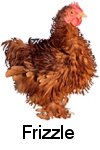


Just what is NOT to love about these freaky chickens?? :-) Alas, all these breeds are banties and, accordingly, lay banty-sized eggs. At Casa Rodgers, we'd call banty eggs "rooster eggs", since no self-respecting hen would ever lay such a cheap egg. You may be as amused as we are when our city-slicker friends are amazed at the concept of "rooster eggs" as they had NO IDEA that roosters even laid eggs.
::thunk head on wall::
The problem with banties, besides the rooster egg thing, is that you can't know the sex of the chicken prior to purchase. You gets what you gets. Some years we'd get a bunch of roosters (worthless things). After they'd mature to crow obnoxiously and/or mean enough to attempt to attack us (uh .... listen up, bird brain, ever stop to think that attacking an entity a lot BIGGER and a lot SMARTER than you isn't a terrifically intelligent thing to do?), we rid ourselves of them. All very humanely, of course. :-)
As the years went on, the girls and I were dissuaded from getting more banties, as interesting as they were. This was very sad because having those really unusual and pretty birds was just about the only aspect about them that we liked. ::sigh::
Our flock(s) have ranged from 6 to 20 ... right now we are down to 1 rooster (Rhode Island Red) and 5 hens:




Yes, I know there are only 4 pictures here ... that's cuz we have 2 Rhode Island Reds! We used to have 3 Barred Rocks ... but 2 were invited to dinner one night and never made it home. We assume some local canine had a finger-lickin' good meal. :-)
The hens are all very mature and some days they just don't feel like sitting down on the job, ya know? On those days, we don't get any eggs. This isn't right. Hens are supposed to be laying one egg per day ... it doesn't matter if we use them or not ... that's what the output is supposed to be! I especially want to caution the Ameraucana that if she doesn't start laying eggs, she's going to be taking the Rubber Chicken Cruise very soon.
 How do I know that the Ameraucana isn't laying any eggs? Heck, that's the easiest thing .... Ameraucanas lay GREEN eggs! No lie! And we just are not getting a whole lotta green eggs these days.
How do I know that the Ameraucana isn't laying any eggs? Heck, that's the easiest thing .... Ameraucanas lay GREEN eggs! No lie! And we just are not getting a whole lotta green eggs these days.
Now, if we only had some ham to go with that, Sam-that-I-am! :-)
Now that it's Spring, it's new chickie time again! Oh joy ... we get to keep the new chickies inside the house until they get big enough to be sent to the ... heh heh heh ... Big House. :-) We can see on the website of our Feed Store when the new chickies arrive and what breeds they are. I was told that they sell over 300 chickens PER WEEK. PER WEEK. Holy moley ... where are all those chickens going? I live in suburbia ... it's not like we are real rural here.
It's definately first come / first serve ... snooze you, lose. We were a day late in making the (short) trek over and lost out on this week's shipment of Ameraucanas. ::sigh:: We'll need to be Johnny-on-the-spot next week.
So, what breeds did we get?
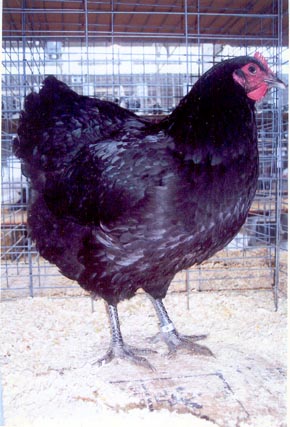 This is a Black Jersey Giant hen. The breed was originated in New Jersey during the 1880's. When grown the black feathers take on a green sheen within the black color. The hens can reach about 10 lbs and lay large to extra-large eggs that are pale cream to dark brown in color.
This is a Black Jersey Giant hen. The breed was originated in New Jersey during the 1880's. When grown the black feathers take on a green sheen within the black color. The hens can reach about 10 lbs and lay large to extra-large eggs that are pale cream to dark brown in color.
 This is an Australorp hen. The breed was developed in Australia from Black Orpington stock. Hens will start laying eggs at 5-6 months. Weight: Standard hen weighs 6 1/2 lb. The hens can reach about 6-1/2 lbs and lay light brown eggs.
This is an Australorp hen. The breed was developed in Australia from Black Orpington stock. Hens will start laying eggs at 5-6 months. Weight: Standard hen weighs 6 1/2 lb. The hens can reach about 6-1/2 lbs and lay light brown eggs.
If we get to the Feed Store in time, we plan to get some Golden Laced Wyandottes, some more Rhode Island Reds, Wellsummers and Lakenvelder Golds. (pictures and verbage to follow, if we get them) Why? Because they are DIFFERENT from the ordinary, stereotypical chickens!
OH!! News flash! I was just mildly whining complaining reminiscing about the cute and bizarre breeds we used to have. And Mr. Pirate ... the gem that he is .... has succumbed! Oh hooray! If I can find some mutant chickens, I can get them. [grin]
As for the new chickies that we just got ... we need to wait until several months old before they'll come online. But for now, the eggs that we're getting are more than enough for our purposes. :-)
Date: May 2010
All of our older chickies have been moved out the Big House, where they have an enclosure to live in and keep them safe from the big hens. Ever hear of the term "pecking order"? Well, the hens invented it. They will harrass the new chickies, sometimes to the chickies' fatal detriment, so everyone needs to become adjusted to each other whenever there are newcomers. The enclosure has two openings large enough for the larger chicks to go in & out but too small for the large hens.
About 4 weeks ago, I *was* able to get to the Feed store and obtain Golden Laced Wyandottes, Wellsummers and Lakenvelder Gold chickies. The chickie pictures are fairly boring, but the full grown hens are very attractive.
 Here's the Golden Laced Wyandotte.
Here's the Golden Laced Wyandotte.
The Wyandotte is a breed of chicken originating in the United States. Joseph McKeen of Wisconsin was the originator of the Golden Laced Wyandotte. In 1880 he crossed Silver Laced Wyandotte females with a large "Black Red" patterned fowl of unknown origin called the Winnebago.
They tend to be quite friendly, and not flighty, and so make good pets for people. They are also very vocal, uttering soft clucks on a regular basis. The Golden Laced Wyandotte is a golden color with black around the edge of every feather and black tail.
The hens, weighing about 6 pounds, will lay around 200 eggs a year with an exceptional hen laying around 240 eggs a year. The eggs are brown or tinted.
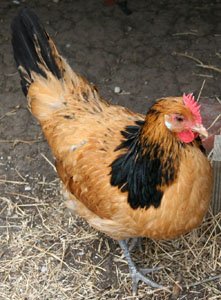 This is a Lakenvelder Gold. The Lakenvelder is a Dutch breed from the dutch town Lakervelt OR was developed in the 1830ís in Germany despite their Dutch name, depending on your source. They were first exhibited in England in 1902.
This is a Lakenvelder Gold. The Lakenvelder is a Dutch breed from the dutch town Lakervelt OR was developed in the 1830ís in Germany despite their Dutch name, depending on your source. They were first exhibited in England in 1902.
The Lakenvelder is an attention getter with it's graceful carriage and contrasts of black and white plumage (or in our case, black and "gold" plumage). They like to be busy. Eggs are small to medium in size and brown tinted white color.
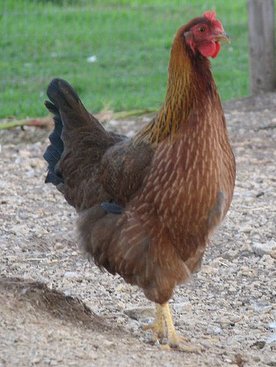 The Welsummer hen lays the darkest brown eggs ever; in fact, they are called "chocolate" eggs! A hen will lay an average of 3 large eggs per week.
The Welsummer hen lays the darkest brown eggs ever; in fact, they are called "chocolate" eggs! A hen will lay an average of 3 large eggs per week.
The breed originally from the small village of Welsum, in the eastern Netherlands. It is a light, docile breed, with rustic-red and orange colour. Representations of roosters in the media are often based upon the "classic" Welsummer look. The most common example of this would be the Kelloggs Cornflakes rooster.

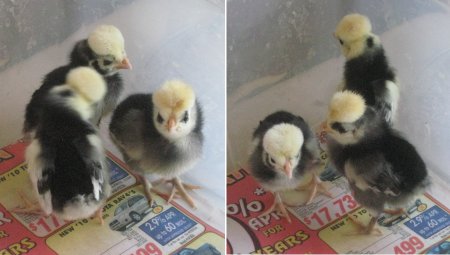 However, we have ONE LAST batch of chickies in the house, waiting until they are old enough to move out to the Big House. The picture to the right is of White-Crested Black Polish chickies. They are soooo cute! When we got our very first White-Crested Black Polish, we rather thought it looked like Dennis Rodman, and so it was named Dennis.
However, we have ONE LAST batch of chickies in the house, waiting until they are old enough to move out to the Big House. The picture to the right is of White-Crested Black Polish chickies. They are soooo cute! When we got our very first White-Crested Black Polish, we rather thought it looked like Dennis Rodman, and so it was named Dennis.

We soon realized that since this chickie was a hen, it just wasn't right to call her "Dennis" ... identity conflicts, you understand ... so we renamed her Denise. As we had a second White Crested Black Polish, we named her DaMoose. Why? Well, it comes from a Girl Scout camp song about Dead Moose. :-)
 And why is THAT important? Well, ever since all subsequent White Crested Black Polish chickens are automatically named Denise, DaMoose .. and now that we have a third chickie, this one is DaNephew. :-) These silly chickens will grow up to look like the picture on the right. Bizarre. :-)
And why is THAT important? Well, ever since all subsequent White Crested Black Polish chickens are automatically named Denise, DaMoose .. and now that we have a third chickie, this one is DaNephew. :-) These silly chickens will grow up to look like the picture on the right. Bizarre. :-)
A bit of trivia for you .... Polish chickens aren't from Poland, despite the name. These chickens were thought to have developed near the banks of the Po River in Italy - hence their name. It is also one of the oldest, being known as a pure breed as early as the sixteenth century. The hens lay white eggs.